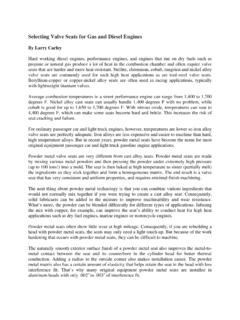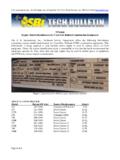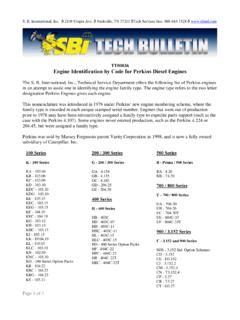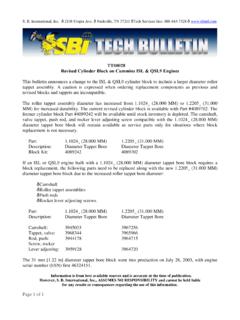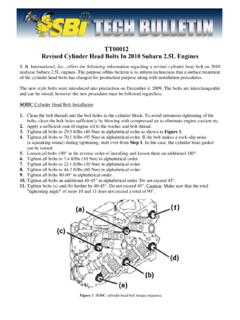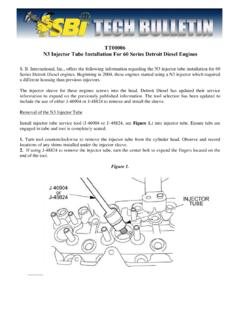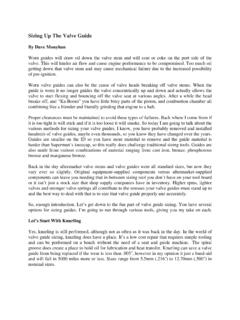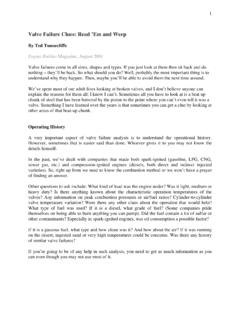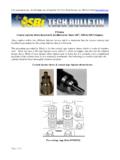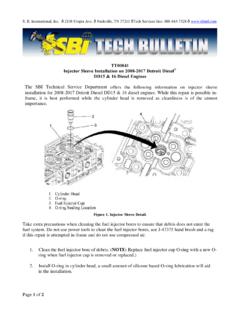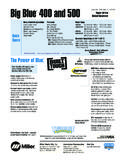Transcription of Diesel Engine Cylinder Head Problems Diagnosis
1 Diesel Engine Cylinder Head Problems Diagnosis Head-related Problems usually involve loss of compression in one or two cylinders, a condition that is signaled by a ragged idle, by increased fuel consumption, and in some instances, by exhaust smoke. An exhaust temperature gauge, with switch-controlled thermocouples on each header, will give early warning. Exhaust from weak cylinders will be cooler than the norm. You can cross-check by disabling one injector at a time while the Engine ticks over at idle. A Cylinder that causes less of an rpm drop than the others does not carry its share of the load.
2 At this point, you can check the injectors (the usual suspects) or else go to the heart of the matter with a cranking compression test. What you are looking for are cylinders with dramatically (at least 20%) lower compression than the average of the others. If the weak Cylinder is flanked by healthy cylinders, the problem is either valve- or head-gasket related; or very low compression in an adjacent Cylinder points to gasket failure. Abnormally high readings on all cylinders indicate heavy carbon accumulations, a condition that might be accompanied by high pressures and noise.
3 The next step is to make a Cylinder leakdown test, which will distinguish between valve and gasket failure. While most compression leaks bleed into adjacent cylinders or across the fire deck to the atmosphere, it is possible for a leak path to open into water jacket. The Engine might seem healthy enough, but overheat within a few minutes of start-up. Coolant in the header tank might appear agitated and might spew violently with the cap removed. A cooling system pressure test will verify the existence of a leak, which can be localized with a Cylinder leak-down test.
4 However, the leak-down test cannot distinguish between cracks in the casting and a blown gasket. Fortunately, it is rare for an Engine that has not suffered catastrophic overheating to leak coolant into the oil sump, where it can be detected visually or, in lesser amounts, by a spectrographic analysis. Likely sources are casting cracks, cracked (wet-type) Cylinder liners, and liner-base gasket leaks. The Cylinder head casting, like the fluid end of a high-pressure pump, will eventually fail. After a large, but finite, number of pressure cycles, the metal crystallizes and breaks.
5 Owners of obsolete engines for which parts are no longer available would do well to keep a spare head casting on hand. Even so, most Cylinder heads fail early, long before design life has been realized, because of abnormally high combustion pressure and temperature. Combustion pressure and heat can be controlled by routine injector service (dribbling injectors load the cylinders with fuel), attention to timing, and conservative pump settings. Cooling system maintenance usually stops when the temperature gauge needle remains on the right of center. But local overheating is as critical as radiator temperature and is rarely addressed.
6 According to engineers at Detroit Diesel , 1/4 in. of scale in the water jacket is the thermal equivalent of 4 in. of cast iron. Eroded coolant deflectors and rounded-off water pump impeller blades can also produce local overheating, which will not register as a rise in header-tank temperature. Local overheating on air-cooled engines can usually be traced to dirty, grease clogged fins or to loose shrouding. Gasket life can be extended by doing what can be reasonably done to minimize potential leak paths. As explained below, some imperfection of the head and fire deck seating surfaces must, as a practical matter, be tolerated.
7 Fasteners should be torqued down to specifications and in the suggested torque sequence, which varies between Engine makes and models. Asbestos gaskets, without wire or elastomer reinforcements, take a set and must be periodically retightened. Newer, reinforced gaskets hold initial torque, but proper Diesel maintenance entails retightening head bolts periodically. From
